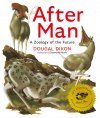By: Dougal Dixon(Author), Desmond Morris(Introduction By), Diz Wallis(Illustrator), John Butler(Illustrator), Brian McIntyre(Illustrator), Philip Hood(Illustrator), Roy Woodard(Illustrator), Gary Marsh(Illustrator)
144 pages, colour & b/w photos, colour & b/w illustrations
An expanded reproduction of one of the most prominent works of speculative zoology, After Man enthrals as much as it did 40 years ago.
![After Man After Man]()
Click to have a closer look
About this book
Customer reviews
Related titles
Recommended titles
About this book
An expanded edition of Dougal Dixon's classic illustrated work of speculative biology, published to celebrate the book's 40th anniversary. Features a new cover and more than 10 pages of never before seen sketches and production material.
In 1981 St Martin's Press published After Man, the first edition of palaeontologist Dougal Dixon's vision of an 'alternative evolution': one without mankind. To some, this was seen as sacrilege, but Dixon himself only ever saw the decision to obliterate his own species from his vision as a practical one. Reflecting in the new foreword he has written exclusively for this edition, he notes, 'the book was about the natural forces of evolution, and man, with his big feet and his big hands, had too much of an influence, twisting the course of nature away from anything that can be predicted. With the removal of this interference, I was able to let nature get back to work'.
While some of the creatures rent from Dixon's imagination seem every bit as fantastical to a modern reader as they appeared to readers in the early '80s, others now don't seem so very far-fetched. From Dixon's foreword: 'There are now the walking bats of New Zealand – not quite as extreme and spectacular as 'The Nightstalker', but getting there. Fossils of even larger species of these bats are now being found in the same region. Then there are the snakes in Mexico that live in caves and snatch flying bats out of the air, just like 'The Anchorwhip'.
Customer Reviews
By: Dougal Dixon(Author), Desmond Morris(Introduction By), Diz Wallis(Illustrator), John Butler(Illustrator), Brian McIntyre(Illustrator), Philip Hood(Illustrator), Roy Woodard(Illustrator), Gary Marsh(Illustrator)
144 pages, colour & b/w photos, colour & b/w illustrations
An expanded reproduction of one of the most prominent works of speculative zoology, After Man enthrals as much as it did 40 years ago.
"Uncannily believable. Dixon's invented animals, some of them beautiful enough to live, engender reflection about the mysterious forces at work beneath the skin of real animals."
– The New York Times Book Review
"A fascinating, elegant fantasy."
– Boston Globe
"After Man is grand fun and marvelously imaginative."
– The Los Angeles Times Book Review
"[Dixon's] brief explanation of the principles of evolution is so lucid, and the detailed illustrations of futuristic beasts are so charming, that After Man is bound to captivate readers of all ages."
– Chicago Sun-Times
"An extraordinary book! There are wonders on every page. After Man is an extrapolative tour de force."
– Isaac Asimov's Science Fiction Magazine
"Stunning in execution and implication, this will be a decided treat for futurist biology student or enthusiast, science fiction fan and general reader."
– Booklist















